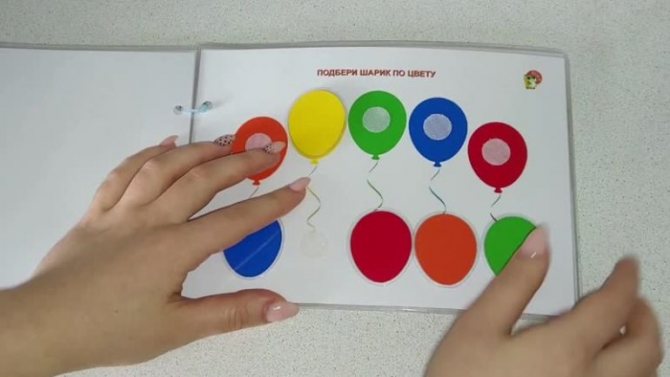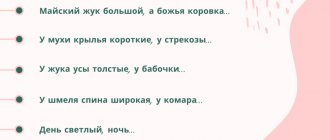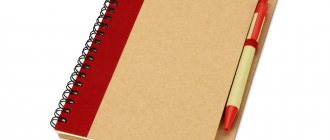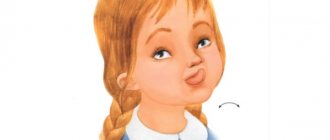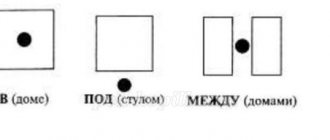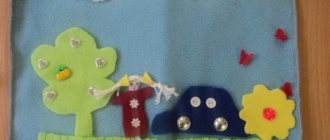Caterpillar
The didactic game reinforces the idea of the main colors - red, yellow, green, blue.
The lesson promotes:
- the desire for knowledge;
- development of speech skills;
- formation of analytical ability and logic;
- development of attentiveness, perseverance, independence;
- gaining the ability to work with templates.
The activity requires four illustrations of caterpillars as empty circles with painted heads, as well as four colored circles of the appropriate diameter.
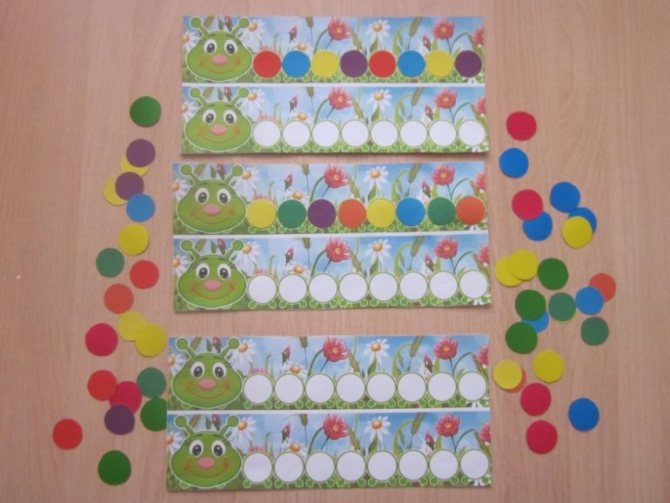
Children must make caterpillars from circles, guided by the color of their heads.
For older children, you can complicate the task: cut out circles of light-dark or warm-cold tones, ask them to arrange the caterpillars from beginning to end.
Match items by color
The collective game “Select objects by color” helps to memorize the names of the main tones of the palette - brown, red, orange, yellow, green, blue, purple, gray, black, white (you can use all or several of the above).

The lesson develops:
- memory, thinking, attentiveness;
- speech skills;
- perseverance, diligence;
- the ability to visually perceive objects;
- motor skills of fingers;
- culture of collective behavior.
For the game, you need to prepare cardboard sheets painted in the selected colors, and cards depicting animals, plants, fruits, and things of appropriate shades.

The teacher lays out cardboard on the table. Pupils take turns taking the illustration they like, saying what it depicts and what color the object is drawn. Place the card on the corresponding cardboard sheet.

Children can be divided into groups according to the number of sheets of cardboard. Participants must take only those cards that match the color of the group.
Place flowers in a vase
This version of the “Match by Color” game reinforces the idea of three basic tones - blue, red, yellow.
Lesson objectives:
- formation of cognitive and analytical abilities;
- improving finger motor skills;
- fostering perseverance, diligence, and the ability to work productively in a team;
- development of speech, expansion of vocabulary by including words related to the tones of the palette;
- improving the ability to visually perceive objects.
For the didactic game, you need to cut out three vases and many flowers of three corresponding colors from cardboard. The teacher places vases on the table and puts the flowers into piles according to color. Gives the children the task of choosing the correct group of flowers for each vase.

You can complicate the task to develop logic and attentiveness, mix the flowers in one pile. Pupils must correctly distribute the flowers among the vases.
Color and shape. Games with children 2-3 years old
Find the same figure.
Goal: To form an idea of the shape of objects. Learn to find identical objects by color and shape. Enrich your vocabulary with names of various shapes: circle, square, triangle. Reinforce knowledge about primary colors.
For the game you will need cards for each child with images of geometric shapes. The card shows two circles, a triangle and a square - a total of four shapes of different colors. The colors of the figures are different on all cards.
The teacher has geometric shapes: circles, squares, triangles of different colors.
At the beginning of the game, a bear cub addresses the children. He says that he was given a colored mosaic, he played with it, but now he can’t put it together correctly. Let's help the little bear.
The teacher takes one figure at a time and shows it to the children, while naming the figure by color and shape: “Here is a yellow triangle, who has the same mosaic?”
Children look at their cards, see if they have exactly the same figure. If the child finds the same figure, he takes the mosaic from the teacher and covers his figure with it. If no one takes the shown figure, then it is put aside.
The winner is the one who covers the figures on his card the fastest.
At the end of the game, the bear cub thanks the guys for their help.
Next time, new geometric shapes are added: rectangle, oval.
Let's put things in order.
Goal: To introduce children to the circle. Give the concept that a circle is the general shape of some objects.
To play you will need: Figures or toys of hares, a wheel, buttons, doll plates.
Once upon a time there lived a hare Kasyan. So he went into the forest and saw the wheel lying there. He wanted to take the wheel home, but he didn’t know if it was possible, in case it was someone else’s. A magpie flies past and sees a hare in thought. And this magpie knew everything about everything. And she says to the hare: “Take the wheel, it’s no one’s.”
The hare wanted to lift the wheel, but he couldn’t, it was too heavy. How can a hare carry a wheel home? (children's answers)
If the children do not guess on their own, the teacher shows how to roll the wheel.
So the hare Kasyan rolled his wheel home, and at home he was greeted by a hare and her babies. The rabbits saw the wheel and said: “Where did you get such a big button?”
“What kind of button is this, this is a plate,” says the hare.
“This is not a button or a plate, this is a wheel,” says the hare Kasyan. But the hare and the bunnies do not agree with the hare. The little bunnies shout: “Button.” The hare shouts: “Plate.”
This is how the hares argued, because they don’t know what a wheel, a plate and a button have in common.
What do you think these items have in common? Children look at a wheel, buttons, doll plates (children's answers).
After listening to the children’s answers, the teacher concludes: “All these objects have the same shape, they are round. All round objects roll."
Let's show the hares that the shape of these objects is the same. Children trace objects with their fingers and draw a circle with their fingers in the air.
Find the round object
.
Goal: Learn to find round objects among other objects. Develop mental operations: analysis and comparison. Enrich children's vocabulary.
To play you will need tables with four cells. A circle is drawn in the first cell, the remaining cells are empty. Object pictures, among which there should be round objects.
One day the bunnies were left alone at home and got so naughty that they scattered all the things from the closet. But soon the hare and the hare will return. The bunnies got worried, now the parents will come and argue. We need to put things in closets. Let's help the bunnies. You need to put round objects in the empty cells - boxes.
The teacher asks the kids to trace the drawn circle in the first cell with their finger.
“What objects do we need to find?” (round). The teacher explains that you need to take a picture and circle the object with your finger to determine whether it is round.
When the children complete the task, the teacher offers to tell the bunnies what objects the children put in the empty squares: Round clock, round table, round ball, round plate.
Mathematics for children 2-3 years old
Didactic games for children 2-3 years old.
Color Didactic games for children 2-3 years old.
Color and shape. 2014-10-26 15:37 admin
Multi-colored balls
The didactic game “Match balls by color” reinforces ideas about the basic tones of the palette and develops the ability to correlate objects by shade. The exercise promotes speech development and attentiveness.
To play, you need a picture depicting a boy or girl with multi-colored ropes in his hand. You need to cut out balloons of the appropriate colors from cardboard.

The teacher, pointing to the picture, explains that the balloons came off and flew away. The task of preschoolers is to find the balloons that have flown away and correctly attach them to the ropes.
